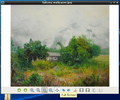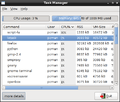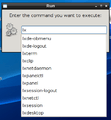LXDE
 | |
|
Default LXDE desktop | |
| Original author(s) | Hong Jen Yee ("PCMan") |
|---|---|
| Developer(s) | The LXDE Team |
| Initial release | 2006 |
| Stable release | 0.10 (LXQt) / November 2, 2015 |
| Preview release | 0.99.0 / October 24, 2014[1] |
| Development status | Active |
| Written in | C (GTK+ 2), C/C++ (Qt 5) |
| Operating system | Unix-like |
| Type | Desktop environment |
| License | GNU GPL, GNU LGPL |
| Website |
lxde lxqt |
LXDE (abbreviation for Lightweight X11 Desktop Environment) is a free desktop environment with comparatively low resource requirements. This makes it especially suitable for resource-constrained personal computers[2] such as netbooks or system on a chip computers.
Overview
LXDE written in the C programming language, using the GTK+ 2 toolkit, and runs on Unix and other POSIX compliant platforms, such as Linux and BSDs. The goal of the project is to provide a desktop environment that is fast and energy efficient.[3][4]
In 2010, tests suggested that LXDE 0.5 had the lowest memory usage of the four most popular desktop environments of the time (GNOME 2.29, KDE Plasma Desktop 4.4, and Xfce 4.6),[5] and that it consumed less energy,[6] which suggests mobile computers with Linux distributions running LXDE 0.5 drained their battery at a slower pace than those with other desktop environments.
LXDE is the default desktop environment of Knoppix, Lubuntu, LXLE Linux, Peppermint Linux OS and Raspbian, among other distributions.
LXDE uses rolling releases for the individual components (or group of components with coupled dependencies).[7] The default window manager used is Openbox, but a third-party window manager may be configured to be used with LXDE, such as Fluxbox, IceWM or Xfwm.[8] LXDE includes GPL-licensed code as well as LGPL-licensed code.[3]
History
The project was started in 2006 by Taiwanese programmer Hong Jen Yee (Chinese: 洪任諭; pinyin: Hóng Rènyù), also known as PCMan, when he published PCManFM, a new file manager and the first module of LXDE.
Comparing Linux distribution rankings for DistroWatch in early January 2011 for the year 2010 versus 2009, Ladislav Bodnar noted the increase in popularity of LXDE versus other desktop environments. He said, "Looking through the tables, an interesting thing is the rise of distributions that use the lightweight, but full-featured LXDE desktop or the Openbox window manager. As an example, Lubuntu now comfortably beats Kubuntu in terms of page hits, while CrunchBang Linux, a lightweight distribution with Openbox is still in the top 25 even though it failed to produce a stable release for well over a year. Many other distributions started offering LXDE-based editions of their products, further contributing to the dramatic rise in popularity of this relatively new desktop environment."[9]
Qt port
Dissatisfied with GTK+ 3,[10] Hong Jen Yee experimented with Qt in early 2013[11] and released the first version of a Qt-based PCManFM on 26 March 2013.[10] He clarified, though, that this means no departure from GTK+ in LXDE, saying “The Gtk+ and Qt versions will coexist”. He later ported LXDE’s Xrandr front-end to Qt.[12]
On 3 July 2013 Hong Jen Yee announced a Qt port of the full LXDE suite.[13] And on 21 July 2013, Razor-qt and LXDE announced that they are merging the two projects.[14][15][16] The merger of LXDE-Qt and Razor-qt was renamed LXQt,[17] and the first release, version 0.7.0, was made available on 7 May 2014.[18] Version 0.8.0, bringing with it full Qt 5 compatibility, was made available on 13 October 2014.[19]
LXQt version 0.9 was released in February 2015, featuring heavy internal cleanups and refactorings. All compatibility with Qt 4 was dropped, requiring Qt 5 & KDE Frameworks 5. Qt 5.3 is now the minimum required version.[20][21]
Software components of LXDE
LXDE has forked a couple of the GNOME Core Applications and written several from scratch. Unlike other major desktop environments such as GNOME, the components of LXDE have few dependencies and are not tightly integrated.[22] Instead, they can be installed independently of each other or LXDE itself.[23]
LXDE consists of several components:
| Components | Descriptions | Notes |
|---|---|---|
| PCMan File Manager | File manager and Desktop metaphor provider | |
| LXInput | Mouse and keyboard configuration tool | |
| LXLauncher | Easy-mode application launcher | |
| LXPanel | Desktop panel | |
| LXSession | X session manager | |
| LXAppearance | GTK+ theme switcher | |
| GPicView | Image viewer | |
| LXMusic | A frontend for the XMMS2 audio player | |
| LXTerminal | Terminal emulator | |
| LXTask | Task manager | |
| LXRandR | A GUI to RandR | |
| LXDM | X display manager | |
| SDDM | display manager supporting both X11 and Wayland; default by LXQt | Not developed by the LXDE project |
| LXNM | Lightweight network connection helper daemon. Supports wireless connections (Linux only). | Discontinued |
| Leafpad | Text editor | Not developed by the LXDE project |
| Openbox (Fluxbox, IceWM and Xfwm are also supported) | Window manager | Not developed by the LXDE project |
| obconf | A GUI tool to configure Openbox | Not developed by the LXDE project |
| Xarchiver | File archiver | Not developed by the LXDE project |
-

GPicView
-

LXAppearance
-

LXPanel
-

LXPanel Preferences
-

LXTask
-

PCManFM
-

Autocompletion of Panel tasks
See also
References
- ↑ LStranger (2014-10-24). "LXDE-Common 0.99.0 released". Retrieved 2015-01-21.
- ↑ Christopher Smart (2009-09-09). "Lubuntu: Floats Like a Butterfly, Stings Like a Bee". Linux Magazine. Retrieved 2009-09-10.
- 1 2 LXDE Team. "LXDE". Retrieved 2008-10-26.
- ↑ LXDE Team. "About LXDE". Retrieved 2008-11-01.
- ↑ Larabel, Michael. "Power & Memory Usage Of GNOME, KDE, LXDE & Xfce". Phoronix. Retrieved 30 July 2011.
- ↑ Larabel, Michael. "Power & Memory Usage Of GNOME, KDE, LXDE & Xfce (page 2)". Phoronix. Retrieved 30 July 2011.
- ↑ "Description of current release process". Article.gmane.org. Retrieved 2014-05-19.
- ↑ "LXDE". Retrieved 2016-01-12.
- ↑ Bodnar, Ladislav (January 2011). "DistroWatch Page Hit Ranking statistics in 2009 and 2010". DistroWatch. Retrieved 4 January 2011.
- 1 2 "PCManFM Qt 0.1.0 released". LXDE Blog. 2013-03-27. Retrieved 2013-05-04.
- ↑ "PCManFM file manager is ported to Qt?". LXDE Blog. 2013-02-19. Retrieved 2013-05-04.
- ↑ "LXDE xrandr GUI frontent lxrandr is ported to Qt in one day". Gmane. Retrieved 2013-05-04.
- ↑ "LXDE - LXDE-Qt Preview". Blog.lxde.org. 2013-07-03. Retrieved 2014-03-27.
- ↑ brother (2013-07-22). ""The future of Razor and LXDE-Qt"". Blog.lxde.org. Retrieved 2014-05-19.
- ↑ "The future of Razor and LXDE-Qt at Razor-qt Google group". Groups.google.com. Retrieved 2014-05-19.
- ↑ ""The future of Razor and LXDE-Qt" at the LXDE-list archive". Sourceforge.net. 2013-07-20. Retrieved 2014-05-19.
- ↑ "The First Alpha Release of LXDE-Qt (or LXQt) is in Preparation". Blog.lxde.org. 2014-04-27. Retrieved 2014-05-07.
- ↑ "LXQt 0.7.0 released". Blog.lxde.org. 2014-05-07. Retrieved 2014-05-07.
- ↑ Leclanche, Jerome (14 October 2014). "LXQt 0.8.0 released!". LXDE Official Blog. Retrieved 8 January 2015.
- ↑ "LXQt". lxqt.org. Retrieved 10 February 2015.
- ↑ "LXDE - Lightweight X Desktop Environment". sourceforge.net. Retrieved 13 October 2015.
- ↑ Łukasz Bigo. "LXDE - lekka alternatywa do GNOME". Retrieved 2008-08-08.
- ↑ "About LXDE". Lxde.sourceforge.net. Retrieved 2014-05-19.
External links
| Wikimedia Commons has media related to LXDE. |
| ||||||||||||||||||||||||||||||||||||||||||||||||||
| ||||||||||||||||||||||||||||||||||||||
